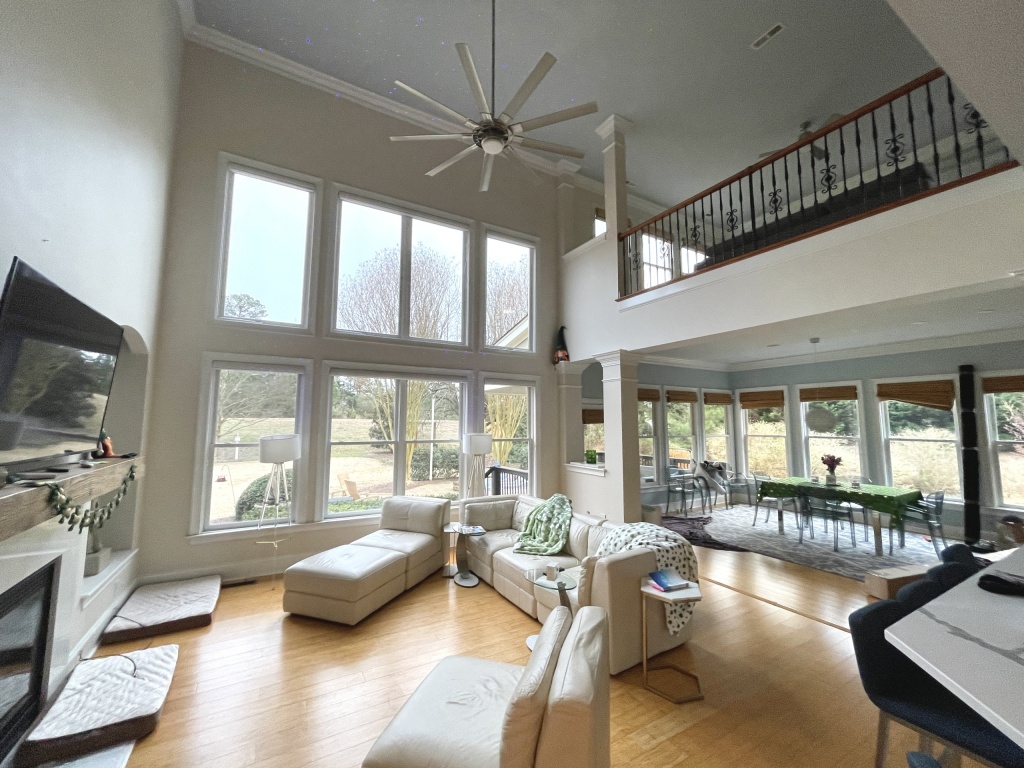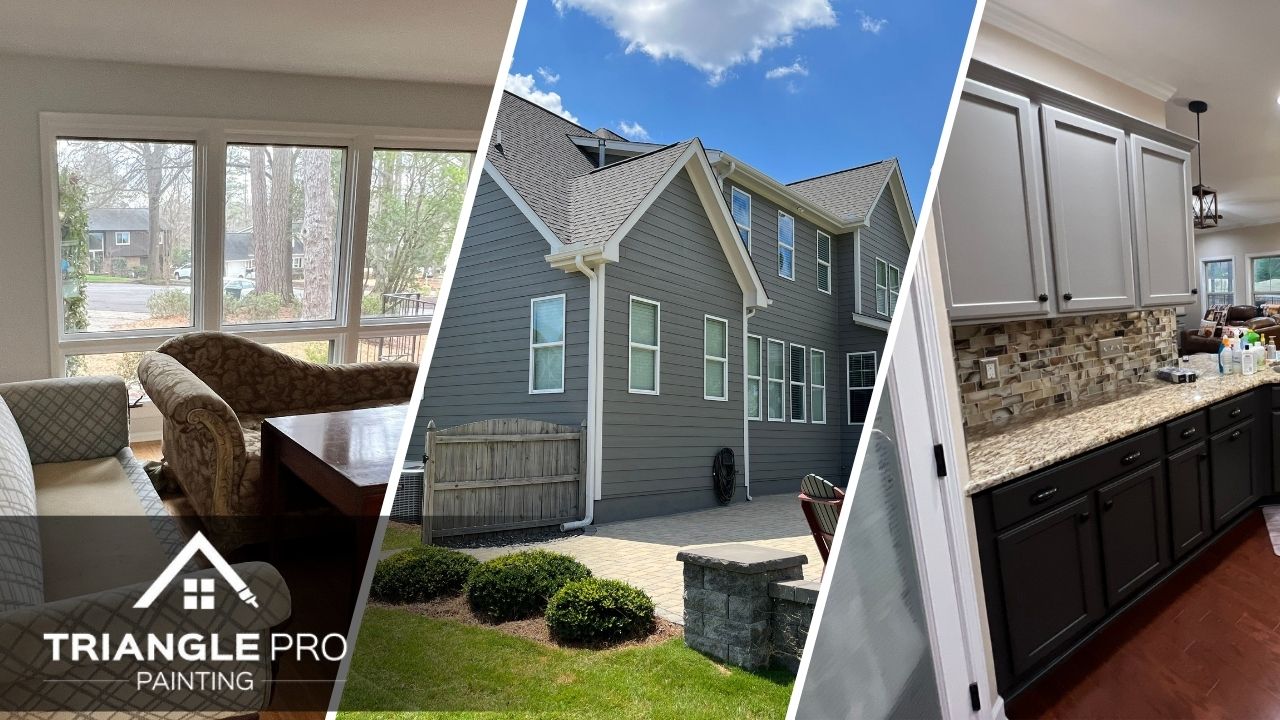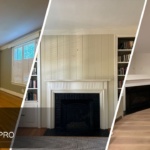Choosing the right paint colors for your home can feel overwhelming. As Raleigh’s trusted painting professionals at Triangle Pro Painting, we’ve helped hundreds of homeowners transform their spaces with the perfect color choices. Let’s break down the process room by room to make your color selection journey easier and more enjoyable.
Why Paint Colors Matter More Than You Think
Before we dive into specific rooms, let’s understand why color choice is so important:
- Colors affect your mood and energy levels
- The right colors can make rooms feel larger or cozier
- Paint colors can dramatically impact your home’s value
- Different rooms need different colors based on their use
- Natural light plays a huge role in how colors look
Living Room: Creating Your Perfect Gathering Space
Your living room is where you spend most of your waking hours, so the color needs to be just right.
What to Consider:
- How much natural light does the room get?
- What time of day do you use the room most?
- What’s your existing furniture color scheme?
Best Color Choices for Different Living Rooms:
- North-Facing Living Rooms
- Best options: Warm beiges, soft yellows, and creamy whites
- Why they work: These colors help brighten naturally darker spaces
- Popular choice: “Manchester Tan” – adds warmth without feeling too yellow
- South-Facing Living Rooms
- Best options: Cool grays, soft blues, and crisp whites
- Why they work: These colors help balance bright natural light
- Popular choice: “Repose Gray” – stays true throughout the day
- Open-Concept Living Areas
- Best options: Neutral colors with subtle undertones
- Why they work: Creates flow between spaces while maintaining interest
- Professional tip: Consider slightly different shades for connected spaces
Kitchen: The Heart of Your Home
Kitchens need colors that energize and welcome while staying practical for this high-traffic area.
Smart Kitchen Color Strategies:
- For Small Kitchens
- Light colors to make the space feel larger
- Reflective qualities to brighten work areas
- Popular choices: Soft whites, light grays, pale yellows
- For Large Kitchens
- Warmer tones to create intimacy
- Accent colors to define spaces
- Popular choices: Warm greys, sage greens, subtle blues
Practical Tips for Kitchen Colors:
- Choose colors that hide common kitchen stains
- Consider your cabinet colors when selecting wall colors
- Think about resale value – neutral kitchens tend to sell better
- Test colors near your countertops and backsplash
Bedrooms: Creating Your Perfect Retreat
Different bedrooms need different approaches based on who uses them and when.
Master Bedroom Color Guide:
- For Relaxation
- Soft blues and greens promote better sleep
- Warm grays create a sophisticated atmosphere
- Gentle lavenders help reduce stress
- For Romance
- Deeper blues add mystery
- Warm neutrals create intimacy
- Soft pinks add warmth without being too feminine
Children’s Bedrooms:
- For Young Children
- Playful colors that can grow with them
- Easy-to-clean finishes
- Colors that can work with changing décor
- For Teenagers
- More sophisticated color choices
- Colors that work for studying and relaxing
- Trendy without being too age-specific
Home Office: Colors for Productivity
With more people working from home, office colors matter more than ever.
Best Colors for Different Work Styles:
- For Focus and Concentration
- Soft blues and greens reduce eye strain
- Light grays provide a professional backdrop
- Warm whites help with video calls
- For Creativity
- Sage green promotes innovative thinking
- Soft yellow energizes without overwhelming
- Pale blue-greens balance energy and calm
Video Call Considerations:
- Choose colors that look good on camera
- Avoid very bright or dark colors
- Consider adding an accent wall behind your desk
Bathroom: Colors That Work Hard
Bathrooms need colors that can handle moisture while creating the right atmosphere.
Master Bathroom Colors:
- Spa-like blues and greens
- Sophisticated grays
- Clean, crisp whites
- Warm neutrals for coziness
Guest Bathroom Colors:
- Welcoming but neutral tones
- Easy-to-maintain colors
- Colors that coordinate with simple décor changes
Practical Tips for Color Success
Testing Colors the Right Way:
- Sample Testing
- Paint large swatches (at least 2×2 feet)
- Look at colors during different times of day
- View under both natural and artificial light
- Consider seasonal light changes
- Coordination Tips
- Match your existing furniture
- Consider your flooring color
- Think about adjacent room colors
- Plan for artwork and décor
Color Selection Steps:
- Start with the largest room first
- Choose coordinating colors for connected spaces
- Test samples in each specific room
- Consider the whole house color flow
Common Color Mistakes to Avoid:
- Choosing colors that are too bright or saturated
- Not considering your home’s lighting
- Picking colors that clash with fixed elements
- Selecting trending colors that may date quickly
- Not testing colors before committing
Special Considerations for Raleigh Homes
Our Local Light:
- Raleigh’s natural light tends to be warm and bright
- Humidity can affect how colors appear
- Seasonal light changes are significant
Local Style Trends:
- Traditional colors for historic homes
- Modern neutrals for contemporary spaces
- Coastal influences in newer developments
Making Your Final Decision
Professional Tips:
- Trust your instincts – you’ll live with the colors
- Consider your home’s style
- Think about long-term satisfaction
- Remember resale value
- Factor in maintenance needs
How We Can Help
At Triangle Pro Painting, we offer:
- Free color consultations
- Expert advice on color coordination
- Guidance on new color trends
Choosing the right paint colors doesn’t have to be overwhelming. With proper planning and consideration of how you use each space, you can create a home that feels cohesive, comfortable, and perfectly suited to your lifestyle.
Need help selecting the perfect colors for your Raleigh home? Contact Triangle Pro Painting for a free consultation. Our color experts will help you choose colors that you’ll love for years to come, taking into account your home’s unique lighting, architecture, and your personal style preferences.











